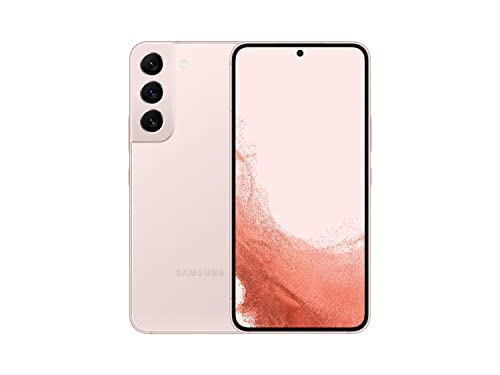If you’re looking for a mid-range budget phone with unique vital features and are confused between Motorola and Samsung brands, this article is for you.
Motorola and Samsung brands have impressive specs at affordable prices.
Motorola prides itself on its value for money, even the highest-spec phones.
And while Samsung is best known for its premium Galaxy S and Galaxy Note lines, the affordable A-series also has several phones for those on a tighter budget.
Motorola vs Samsung: which is the best budget phone in 2024?

Let’s move to our main section, where we will compare Motorola vs Samsung based on budget, build quality, features, and performance, so you will quickly know which phone is best to choose in 2024.
1. Samsung Galaxy S24 Ultra (2024) vs Motorola Edge Plus (2023)
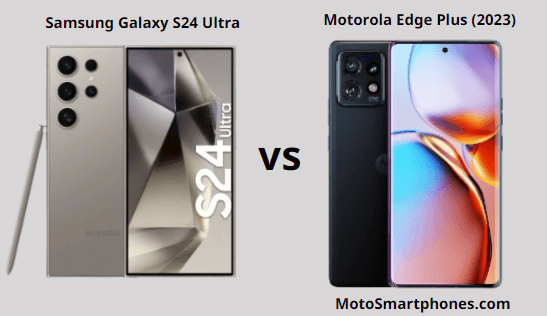
The Samsung Galaxy S24 Ultra vs Motorola Edge Plus (2023) debate compares Samsung’s 2024 latest S series offering with the Motorola smartphone maker’s flagship device.
Every time a new smartphone is released, companies strive to offer improved performance, better cameras, and exciting new features. Both devices currently stand out as the best products from the brand.
This article will provide an overview of both Company’s devices and compare their specifications and performance to determine the overall winner in the battle between the new Galaxy S24 Ultra and Motorola Edge Plus.
The camera is a feature that determines the success or failure of any smartphone. Both devices offer excellent performance in this regard.
Snapdragon Gen 2 processor powers Motorola Edge Plus 2023. However, with the Galaxy S24 Ultra, you get an upgraded Snapdragon Gen 3 processor version, offering better performance than the previous generation.
Additionally, with the launch of Samsung AI, the processor provides enhanced artificial intelligence processing capabilities. Another essential thing in smartphone performance is storage space—the Motorola Edge Plus sports 8GB of RAM, less than the S24 Ultra’s 12GB.
Galaxy S24 Ultra and Edge Plus are powered by a 5000mAh battery. Both devices offer almost the same battery capacity. But the difference lies in the charging capacity.
The Motorola Edge Plus gets the edge with faster 65W charging, ensuring faster turnaround times when you need a boost. Both products offer 15W wireless charging speeds. Considering these factors, Motorola gets extra points in the S24 Ultra battle for battery supremacy.
Conclusion:
The Samsung Galaxy S24 Ultra has an edge over the Motorola Edge Plus. Better performance, camera, and display. It is also equipped with Samsung AI, taking the device to a new level.
While the S24 Ultra emerged as the winner, the Motorola Edge Plus held its ground with its commendable battery life and affordable price tag. But ultimately, the winner will depend on your individual day-to-day needs.
2. Motorola Edge 40 Pro 2024 vs Samsung Galaxy S23 Ultra
The Samsung Galaxy S23 Ultra is one of the most popular Android flagship phones, although it has many features. This is where the new Motorola Edge 40 Pro comes into play.
It’s Motorola’s first fascinating flagship phone in several years, but unlike the big, bulky Galaxy, it offers the same performance in a much thinner and more elegant-looking package. Motorola is also much cheaper than Galaxy S23 Ultra.
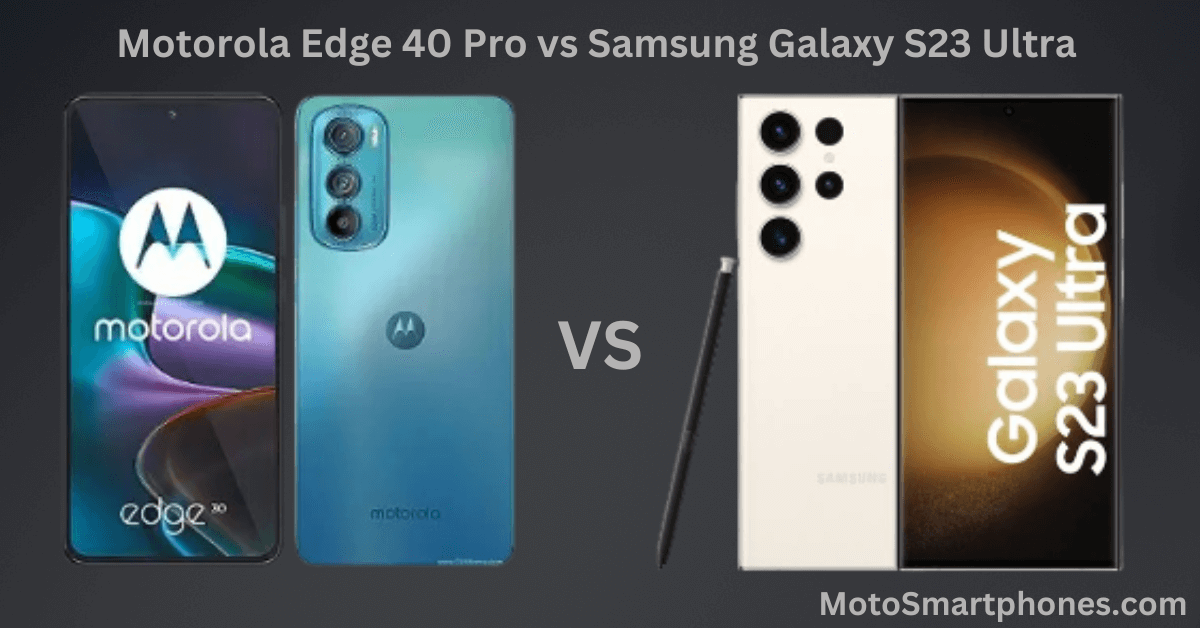
Take a look at the size of the Galaxy S23 Ultra compared to the Motorola Edge 40 Pro! It’s a truly massive phone, and the numbers back it up.
The Motorola is a much thinner and lighter phone, which should not be underestimated. Both have aluminum frames and glass on the front and back, but the Motorola’s soft-touch finish is more memorable (but slipperier).
The Edge 40 Pro’s physical buttons don’t feel as clicky as the Galaxy’s. This is something we particularly noticed with the power button.
As for practicality, both phones feature an IP68 water and dust resistance rating, which you’d expect from a flagship.
Lastly, the Galaxy S23 Ultra has a built-in S Pen, and for those who love the S Pen, the Galaxy S23 Ultra is a natural choice.
The Galaxy S23 Ultra has a 6.8-inch screen, while the Motorola has a 6.7-inch screen, but these numbers don’t fully tell the difference in size. The Galaxy’s display is much larger, and the overall screen area is more significant.
Both screens are bright enough during the day, so it’s nice that the Motorola is catching up, but they don’t get as dim at night as we’d like, so if you use your phone a lot in bed at night, the Galaxy is easier on the eyes.
The Edge 40 Pro 5G has a 50MP primary camera, while Samsung is investing in a 200MP sensor, but as you can see above, the real-world results between the two are very similar. You get images with vibrant colours and good saturation, and you get a look that could be said to be a bit exaggerated.
However, Motorola is no match for the Galaxy regarding telephoto cameras. It only comes with one 2X zoom camera, whereas the Galaxy has two telephoto cameras, one a 3X camera and the other a 10X zoom camera.
On the 5X, you can see that the details on the Motorola start to look worse, while the Galaxy looks much better. At 10x zoom, the Edge 40 Pro’s quality is so poor you won’t want to use the phone, while the Galaxy with that primary camera kills it in detail and sharpness.
The Galaxy has slightly more consistent processing with its ultra-wide camera, but you can see some similarities in the second photo.
Both phones support 8K 30fps video recording with the same viewing angle as 4K. This is great (older phones were scaled down significantly to 8K). Still, because of the larger file sizes of 8K video and 8K TVs or monitors, we recommend sticking with 4K video. Both phones shoot 4K at 30fps or 60fps, but Samsung wins regarding quality.
The Galaxy S23 Ultra has excellent video stabilization, and the Motorola does a decent job, but you can see some shaky artefacts at the edges of the recordings. Another issue we found with the Edge 40 Pro’s 4K video recording is that the image quality suffers slightly due to some overexposure.
For biometrics, both use an in-screen fingerprint scanner, but the technology is slightly different. Galaxy uses Qualcomm’s ultrasonic fingerprint scanner technology, while Motorola invests in optical fingerprint readers. Both work great; the Motorola is somewhat faster.
Motorola and Samsung phones have Qualcomm Snapdragon 8 Gen 2 chips, making them the de facto Android flagship processors in 2024.
Both phones have a base version with 256GB of storage, a step up from the 128GB storage you got last year. However, it’s extraordinary that Samsung decided to cut some corners and only equip the base model with 8GB of RAM. Motorola didn’t lower the price and even provided the base version with 12GB of RAM.
As you can see from the benchmarks, the Motorola is better optimized for gaming as it has progressively slower throttling. Still, most of its numbers are similar to all the others.
Both phones may run on Android 13 as well, but the interfaces on top are pretty different. Samsung’s One UI has features; you can see how it offers more features than Motorola’s skin.
But Motorola ensures a clean look with clever gestures that you can easily get used to. We honestly wish Samsung would also have a gesture to launch the camera by rotating it or a double-cut feature to launch the camera.
Samsung’s most significant promise is to update its phones with major OS updates for four years and security updates for five years. On the other hand, Motorola has a poor track record regarding software updates, which is incredibly annoying when buying an expensive phone like this. Still, that’s okay, as Motorola promises three years of OS updates for the Edge 40 Pro.
Both phones are equipped with dual speakers. The main speakers are both bottom-firing speakers, but the Galaxy has a secondary speaker built into the earpiece, while the Motorola has a second speaker that fires upwards.
Given that Motorola’s battery size is almost 8% smaller, we expected a bit of a compromise regarding battery life. Still, this phone has solid battery performance, surprising us in real-world use.
Motorola’s 120W charging and Galaxy’s maximum charging speed is 45W. And while charging the Galaxy entirely takes about 1 hour and 10 minutes, the Motorola is fully set in just 25 minutes. That means you can skip the overnight setting, and just 10 to 15 minutes of charging will give your Motorola enough Power to last a full day. Impressive stuff.
Both phones support wireless cowering but at a much slower rate. The Motorola has wireless charging speeds of up to 15W, while the Galaxy is much slower, with a maximum speed of 10W.
Conclusion:
The Edge 40 Pro 5G is the best Motorola phone company ever released in years. It boasts incredible performance and will be most appreciated by those who value a well-designed phone with excellent gaming performance while weighing less than a ton of performance. And yes, it is. Motorola’s much lower price shouldn’t be overlooked either.
The Motorola isn’t an ultra-high-end camera phone, and while it performs well enough in most conditions, its camera isn’t entirely up to the level of the Galaxy S23 Ultra.
The Galaxy, however, has everything; even the kitchen sink with more extended software support is also available.
3. Motorola Edge 30 Ultra 5G vs Samsung Galaxy S23 Ultra 2023
Compare the differences between Motorola Edge 30 Ultra 5G and Samsung Galaxy S23 Ultra 2023 in price, display, camera, performance, battery, operating system, and network connectivity.
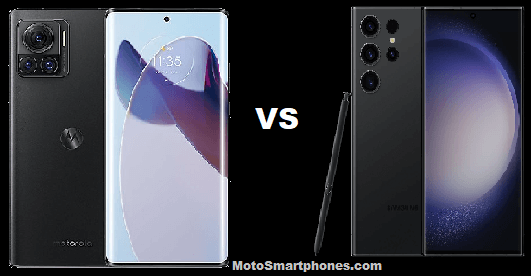
Here is a list of significant differences between the Samsung Galaxy S23 Ultra 5G and Motorola Moto Edge 30 Ultra.
The display on the Samsung Galaxy S23 Ultra 5G is better. An all-new dynamic AMOLED 2x protected by the latest Corning Gorilla Glass Victus 2. It is better in sharpness and splendour with higher brightness, resolution, and pixel density.
This time, Samsung has put a lot of effort into the cameras, introducing four rear cameras, including one 200-megapixel camera and three cameras for different purposes. The Moto Edge 30 Ultra also has a 200MP camera, but the Galaxy S23 Ultra has the upper hand regarding overall image quality, stabilization, and zoom.
The Galaxy S23 Ultra has a better and newer operating system and a newer and faster chipset from the Snapdragon series. It has the best processor and GPU currently available on an Android device.
The Samsung Galaxy S23 Ultra 5G has an IP68 waterproof rating and is available in more colours than the Moto Edge 30 Ultra.
The S23 Ultra 5G was released on February 17, 2023, and the Moto Edge 30 Ultra was released in September 2022.
Conclusion:
The Samsung Galaxy S23 Ultra is unparalleled in specifications and features compared to Moto Edge 30 Ultra. It is arguably the largest smartphone currently available.
Comparing the Samsung Galaxy S23 Ultra 5G and the Motorola Moto Edge 30 Ultra, we think you get the best value for money with the Motorola Moto Edge 30 Ultra.
The Edge 30 Ultra costs less than half that of the Galaxy S23 Ultra, and its features are only a step behind the phone, at $1,379.99. It represents more value for your money.
- 6.8 inches of largest screen with 114.7 cm2
- The phone supported 5G/4G/3G/2G
- 200MP of highest camera resolution
- Snapdragon 8 Gen 2 Processor
- Android 13 operating system
- 6.67 inches of an OLED screen with 1080 x 2400 pixels
- Corning Gorilla Glass 5 for protection
- 256 GB of larger storage with 12GB RAM
- Snapdragon 8+ Gen 1 processor
- With latest Android 12 operating system
4. Motorola Edge Plus VS Samsung S20 Ultra
Let’s compare Samsung and Motorola with their high-end smartphone models.
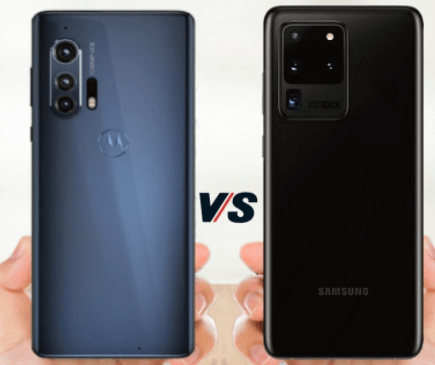
The Motorola Edge Plus stands out from the Android crowd regarding design. This gives the screen a unique and impressive presence, but the appearance of the Edge Plus is somewhat discoloured due to its thickness.
The Samsung Galaxy S20 Ultra is notorious and sometimes uncomfortable, but the Edge Plus is still almost 1mm thicker. This extra thickness is awkward but spoils the modern, contemporary look.
The Galaxy S20 Ultra takes a more significant win with the display. It has a 6.9-inch AMOLED screen, and the Motorola Edge Plus offers a 6.7-inch display. More importantly, the resolution of the S20 Ultra is noticeably higher, resulting in 511 pixels per inch versus just 385 pixels on the Edge Plus. Combined with a higher refresh rate of 120Hz, the S20 Ultra can amaze users with incredibly bright and colourful images, and the Edge Plus’s screen is nice but not close.
The Samsung Galaxy S20 Ultra also indicates that it has an IP68 rating to withstand dust, dirt, and sand and can withstand up to 30 minutes of water at a depth of 1.5m. In contrast, the Motorola Edge Plus does not have an official IP rating, despite Motorola claiming that it has been internally tested to similar standards.
The Samsung Galaxy S20 Ultra and Motorola Edge Plus feature a triple-lens camera system complemented by a time-of-flight (depth) sensor. Interestingly, both smartphones’ primary wide camera lenses offer 108 million pixels.
Pixel binning means using very little 108 megapixels on both cameras but allows for much more detail and dynamics in everyday photography. The Edge Plus also has an 8-megapixel telephoto lens and a 16-megapixel ultra-wide-angle lens. The S20 Ultra has a 48-megapixel telephoto lens and a 12-megapixel ultra-wide-angle camera.
Still, more megapixels don’t necessarily mean better performance, and it’s hard to discern a considerable difference between, for example, the close-up of the S20 Ultra and the close-up of the Edge Plus.
Similarly, the S20 Ultra lets you capture video in 8K, but you’ll need an 8K TV or monitor to view it. As a result, the S20 Ultra’s camera system should be a little better in theory. Still, this round is a tie, as many apparent advantages are not meaningful or practical.
The Motorola Edge Plus and Samsung Galaxy S20 Ultra are equally well-matched in performance. The Qualcomm Snapdragon 865 powers both smartphones with 12GB of RAM. So it’s easy to handle the latest apps and games similarly, but for an extra $200, you can get the S20 Ultra with 16GB of RAM and be much faster (future-proof).
For this extra cost, you also get 512GB of internal storage for the S20 Ultra, while the Motorola Edge Plus standardizes 256GB. Both phones charge up to 1TB of internal memory via an available SD card slot.
In everyday life, the Motorola Edge Plus and the Samsung Galaxy S20 Ultra have massive 5,000mAh batteries. With a storm of this size, both phones can cope with a heavy day of use without recharging, and light users can use them for two to three days.
However, one battery area where the two phones are different is in charge. The S20 Ultra is compatible with 45W fast charging, while the Edge Plus only offers fast charging at 18W. This will allow you to recharge much quicker if you are in a hurry.
As an Android smartphone, the Motorola Edge Plus naturally runs on Android 10. This introduces several subtle improvements to Android, including a new dark theme, improved notification management, and more privacy transparency.
The Samsung Galaxy S20 Ultra works on Android 10 and has Samsung’s new One UI 2.0 overlaid on top. It’s as functional as Android 10 but boasts a more prominent app icon, a streamlined camera UI, and a native screen recorder to simplify the user experience.
Everything is level regarding software, but the S20 Ultra lags behind Samsung’s reputation for being slow to update. This may not necessarily be the case in the future, but for now, it should give the Motorola Edge Plus a narrow win in this round.
The Samsung Galaxy S20 Ultra and Motorola Edge Plus are 5G compatible. More importantly, both are compatible with sub-6 and mmWave 5G networks, allowing you to take advantage of the fastest 5G speeds. However, while Motorola claims the Edge Plus offers “the fastest 5G in the world,” it’s only available on Verizon. This arguably limits the compatibility.
The Samsung Galaxy S20 Ultra starts at $1,400 and is now available on Amazon at $999 for a version with 16GB of RAM and 512GB of internal storage.
On the other hand, the Motorola Edge Plus is much cheaper than the S20 Ultra. The Edge+ is available on Amazon at just $579 with 12GB of RAM and 256GB of internal storage.
Conclusion:
The competition between these two fantastic phones was fierce. The Samsung Galaxy S20 Ultra has technical advantages such as broader availability, lightning-fast charging, strong battery life, and an impressive screen. But in the end, the Motorola Edge Plus took the lead.
Overall, the Galaxy has some impressive features, but the downside is that it’s priced so high that it costs more than the Motorola model. Most consumers wouldn’t want to spend too much extra for video improvements and increased RAM, especially since the overall user experience isn’t much better than the Motorola Edge.
The Motorola Edge Plus is a superphone with rugged specs, a powerful camera, a tireless battery, and an attractive design. For a reasonable $579 price, it’s a good buy in its entirety.
- 6.7 Edge display with 90Hz refresh rate
- With 108MP of Rear Camera
- Qualcomm Snapdragon 865 octa-core processor
- 12GB of RAM along 256GB ROM
- 5000mAh Battery
- Operating System Android 10
5. Motorola Edge+ vs Samsung Galaxy S22 Ultra
We will cover only the Design, Display, Performance, Battery, Camera, and Audio comparison categories. Let’s compare the Motorola Edge+ to the Samsung Galaxy S22 Ultra.

Motorola Edge+ (2022) and Samsung Galaxy S22 Ultra phones are made of metal and glass. However, other protections are used. It has Gorilla Glass 3 on the front and Gorilla Glass 5 on the back of the Motorola Edge+.
On the other hand, the Galaxy S22 Ultra uses Gorilla Glass Victors+ on both the front and back. Samsung is number one here because it offers Corning’s advanced protection.
The two phones are somewhat similar in size. It’s about the same height and thickness, but the Galaxy S22 Ultra is slightly wider. It’s also quite heavy at 228g compared to the Motorola Edge+’s 196g. The Galaxy S22 Ultra has flat top and bottom sides, invalid with the Motorola Edge+. Both phones have moderately curved sides, and both offer curved displays.
Because they are large, using a case for both is better. It’s also worth noting that the Galaxy S22 Ultra has an S Pen stylus that can slide into the S Pen silo inside the device.
Both are pretty different but feel premium in hand. It would be best if you held both hands before deciding. Also, if a big device isn’t interesting, you will not like it either. Both are huge.
The Motorola Edge+ has a 6.7-inch full HD+ (2400 x 1080) OLED display. This display features a 20:9 aspect ratio and a 144Hz refresh rate. It can also display up to 1 billion colours, is HDR10+ certified, and is protected with Gorilla Glass 3. By the way, this display is also curved and delivers roughly 393 PPI.
Conversely, the Galaxy S22 Ultra includes a 6.8-inch QHD+ (3088 x 1440) Dynamic AMOLED 2X display. This panel is also curved and has a 120Hz refresh rate. It can display HDR10+ content and is very bright, with a maximum brightness of 1,750 nits. Gorilla Glass Victus+ protects this display, and we are looking at a 500 PPI display.
The Galaxy S22 Ultra’s panel is much brighter but has a higher resolution. This may not mean much to some users, but you’ll notice the difference if you’re familiar with QHD+ discussions. Both panels feel smooth and offer excellent, vibrant colours and great viewing angles.
Both of these smartphones are well-equipped in terms of hardware. When it comes to performance-related hardware, you can get the best of the best. The Snapdragon 8 Gen 1 fuels both smartphones (Exynos 2200 fuels the Galaxy S22 Ultra in Europe), and both devices include LPDDR5 RAM and UFS 3.1 flash storage.
The Motorola Edge+ comes with 8GB of RAM and 512GB of storage, and you can choose between 8GB and 12GB of RAM inside the Galaxy S22 Ultra, with multiple storage options available. However, neither phone offers expandable storage.
These two smartphones have quite different camera settings. The Motorola Edge+ includes a 50-megapixel primary camera, an ultra-wide camera, and a 2-megapixel depth camera. The Galaxy S22 Ultra has a 108-megapixel primary camera, a 10-megapixel telephoto camera, a 10-megapixel periscope telephoto camera, and a 12-megapixel ultra-wide-angle camera.
The Motorola Edge+ has a 4,800mAh battery, while the Galaxy S22 Ultra comes in 5,000mAh increments. You don’t have to worry about charging either of these two phones until the end of the day. Even with heavy use, two phones can be used all day long.
The Galaxy S22 Ultra isn’t that far off. To be clear, we again tested the Snapdragon version of the Galaxy S22 Ultra.
Motorola supports 68W wired charging, but be aware that there is a 30W charger in the box. 68W must be purchased separately to take advantage of this charging. The device also supports 15W wireless charging and 5W reverse wireless charging.
On the other hand, the Galaxy S22 Ultra supports 45W wired, 15W wireless, and 5W reverse wireless charging. However, for the Galaxy S22 Ultra, there is no charger in the box at all.
Conclusion:
The Motorola Edge+ camera specs don’t look bad on paper, but on the contrary, the camera performance suffers. The subject focus was a significant issue during our use. The phone had important focus issues even after tapping the subject multiple times. The image itself was good in good lighting but not great. The Galaxy S22 Ultra provides more visual detail in these scenes. Motorola may be able to fix some of these issues with a software update.
- New factory unlocked phone
- 108MP of high end resolution
- 8K of recording camera
- eye catching metal glass design
- Long lasting battery life with 45W super-fast charging
6. Samsung Galaxy S22 vs Motorola Moto G71 5G
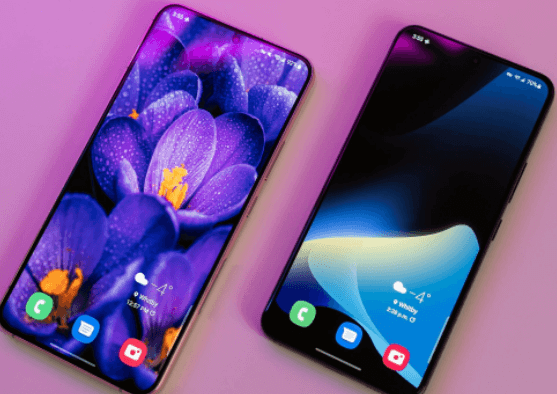
Motorola vs. Samsung 2024’s newest model comparison: Regarding the display, the Samsung Galaxy S22 specs show off a 6.1-inch Dynamic AMOLED 2X with a resolution of 1080 x 2340 pixels. Besides that, the Motorola Moto G71 5G specs boast a 6.4-inch AMOLED resolution of 1080 x 2400 pixels. So the Motorola phone wins this round with a bigger screen.
Under the hood, the Samsung Galaxy S22 camera features a triple 50MP + 10MP + 12MP sensor on the back. Also, the front camera is a 10MP lens. Otherwise, the Motorola Moto G71 5G camera features a 50MP + 8MP + 2MP shooter on the back and a 16MP selfie lens on the front.
If you look closely, the Galaxy S22 has a powerful performance—besides, the Motorola Moto G71 5G debuts with an excellent design and advanced technology. As for the memory department, the Samsung smartphone comes in 128GB/8GB RAM and 256GB/8GB RAM (no card slot). In contrast, the Motorola phone comes with 6GB/8GB of RAM and one onboard storage option, 128GB (no card slot). So, this time, Samsung won the round!
Internally, the Samsung handset is powered by the Exynos 2200/Snapdragon 8 Gen 1 chipset. However, the Motorola device gets its Power from the Qualcomm Snapdragon 695 5G SoC.
Additionally, Samsung deviPowerun the Android 12 operating system, while the competition uses the Android 11 version.
The Samsung machine has a 3700mAh juice box, while the Moto has a larger 5000mAh energy cell. So, the lower the battery, the more Samsung loses in the final round.
Conclusion:
The Samsung Galaxy S22 release date was February 25, 2022, and the Motorola Moto G71 5G came out on January 19, 2022. The Samsung Galaxy S22 price is $799.99. In contrast, the Motorola Moto G71 5G price costs $429.
.In terms of Camera, Samsung bets the Moto G71 5G, while the good news for Motorola lovers is Motorola has a larger battery. Samsung cannon competes with same as Motorola’s bigger screen. The Samsung Galaxy S22 has larger RAM and Storage than the Motorola Moto G71 5G.
Overall, both phones are the Company’s latest model and use advanced technology and high-end materials. And enough cameras to capture all your favourite events.
If your budget is high enough, you can go with the Samsung phone, which costs almost double the price of the Motorola phone. Beyond, if you are searching for a phone that costs less, your best choice is the Motorola Moto G71 5G.
- Outstanding eye catching glass metal glass design
- With a stunning 8K recording
- Brightest display with 50MP resolution
- Bright and colorful screen
- Good battery life with a fast charging of 25W.
- With the 6.4 inches AMOLED Display
- Latest Qualcomm SM6375 Snapdragon 695 5G Chipset
- 6GB/8GB of RAM with 128GB Storage
- Long lasting battery life
- Android 11 operating sys
7. Motorola Moto G22 vs Samsung Galaxy M53
Motorola vs. Samsung budget phones comparison

The Motorola Moto G22 comes out with a gorgeous design. Meanwhile, the Samsung Galaxy M53 is a mid-range device in the Galaxy M family with a large-capacity battery. Regarding batteries, both Samsung and Motorola smartphones use 5000mAh energy boxes.
As for the display, the Motorola Moto G22 specification features a 6.5-inch IPS LCD with 720 x 1600 pixel resolution. Beyond the Samsung Galaxy, M53 specs will feature a 6.7-inch Super AMOLED Plus with 1080 x 2408 pixels resolution. The bigger the screen size, the more the Samsung team wins this round.
Moving on to the optical system, the Samsung Galaxy M53 camera features a quad 108MP + 8MP + 2MP + 2MP lens on the back. On the front is a single 32MP snapper for taking selfies. Otherwise, the Motorola Moto G22 camera will have a quad 50MP + 8MP + 2MP + 2MP rear lens. On the front is a single 16MP shooter for taking selfies. In the final round,
New Samsung devices win with higher camera resolution. So, this battle looks like a victory for the Samsung team.
For the processor, Samsung devices use the MediaTek Dimensity 900 SoC. At the same time, the Motorola handset is powered by the Mediatek Helio G37 chipset. So this time, with better hardware, Motorola devices win.
In addition, both Samsung and Motorola smartphones run the operating system on Android 12.
Internally, the Samsung device has 6GB of RAM and 128GB of onboard storage (expandable to 1TB). The Motorola handset also comes with 4GB of RAM and 64GB of onboard storage (expandable to 256GB). So Samsung phones win this round again with colossal RAM.
Conclusion:
Samsung Galaxy M53 5G has better RAM than Motorola Moto G52. The Motorola Moto G52 has a resolution of 1080 x 2460, and the Samsung Galaxy M53 5G has a resolution of 1600 x 720. Samsung Galaxy has more internal memory than Motorola Moto G52
Overall, the new budget phone from Samsung, the Galaxy M53 5G, is better than Motorola’s Moto G52.
- 6.7 inches of AMOLED+ Display
- Powerful 108MP Quad Camera
- MTK D900 Octa Core 2.4GHz 6nm Chipset
- Large storage with up to 1TB expandable
- One UI 4 Android 12 operating system
8. Samsung Galaxy M52 5G vs. Motorola Edge 30
Motorola recently launched a mid-range smartphone called the Motorola Edge 30. M52 5G smartphone competes with one of Samsung’s most popular models. Both are available at similar prices, so it is not obvious which one to buy. You will learn more about how smartphones compare in this comparison.

The Galaxy M52 5G offers a slightly larger display in a 6.7-inch Super AMOLED that supports a 120Hz refresh rate. On the other hand, the Motorola Edge 30 comes with a 6.5-inch AMOLED display with a 144Hz refresh rate and supports HDR10+.
Edge 30 also has a pixel resolution of 405 pixels per inch and comes with Corning Gorilla Glass 3. It has a pixel density of 393 pixels per inch and is protected with Corning Gorilla Glass 5. So overall, the Samsung Galaxy M52 5G has a slightly better display.
Regarding processing power, the Samsung Galaxy M52 5G has a Snapdragon 778G. As mentioned earlier, the predecessor of the chipset consists of 8 cores and has a maximum clock speed of 2.4 GHz. The processor comes with an Adreno 642L GPU. The Samsung Galaxy M52 5G can score around 520,000 in the Antutu benchmark, which equates to the best device available in its segment.
The Motorola Edge 30 has a new chipset, the new Snapdragon 778G Plus. It has eight cores with a maximum clock speed of 2.5 GHz and an Adreno 642L GPU. The Snapdragon 778G Plus scores around 548,000 in the Antutu benchmark, an excellent score for a mid-range smartphone.
The Motorola Edge 30 Pro should be better. However, both smartphones should be the same fast when playing games or multitasking. The latest Snapdragon 778G Plus may be the best option of the two as it is based on a 6nm architecture and should have better battery management.
You can get a bit higher resolution with the 64M primary camera of the Galaxy M52 5G. Unfortunately, the secondary camera clicks on an ultra-wide image at 12MP resolution, and the third camera clicks on a macro image at 5MP resolution. The front camera of the Galaxy M52 5G is a 32MP shooter. Smartphones can take good-quality photos.
On the other hand, The Motorola Edge 30 comes with a triple camera setup. The native sensor of this smartphone has a resolution of 50 MP with OIS. The secondary sensor also captures ultra-wide images with 50MP resolution. It is also used as a macro camera. Then, there is a third camera to help manage the depth of the smartphone. The front camera of the Motorola Edge 30 is a 32Mp shooter. The Motorola Edge 30 offers a variety of settings along with stabilization compared to the Galaxy M52.
The Galaxy M52 5G has a 5,000mAh battery, while the Motorola Edge 30 has a 4,020mAh battery. The M52 5G’s large battery capacity makes up for it. Both smartphones are charged via the Type-C 2.0 port.
The Galaxy M52 5G has a side fingerprint scanner, while the Motorola Edge 30 has a display fingerprint scanner. Also, the Motorola Edge 30 is slightly thinner than the M52 5G. It is also equipped with stereo speakers, providing a better audio experience for users who consume smartphone content.
Both smartphones should get the latest Android updates for years to come. It is essential to mention that the Motorola Edge 30 will come with 13 5G bands, and the Samsung Galaxy M52 5G will come with 11 5G bands. So, the Edge 30 is slightly better for cellular reception.
Conclusion:
The Motorola Edge 30 is one of the best devices available on the market, while the Samsung Galaxy M52 5G is the cheaper option of the two smartphones. Those looking for an in-display fingerprint scanner and a slightly better processor should opt for the Motorola Edge 30. On the other hand, those looking for a cheaper option can opt for the Galaxy M52 5G.
- 6.5 inches AMOLED display with 1080 x 2400 pixels
- Qualcomm Snapdragon 778G+ 5G
- 8GB of RAM with 128GB storage
- Android 12 Operating System
9. Motorola Moto G10 VS Samsung Galaxy A02s
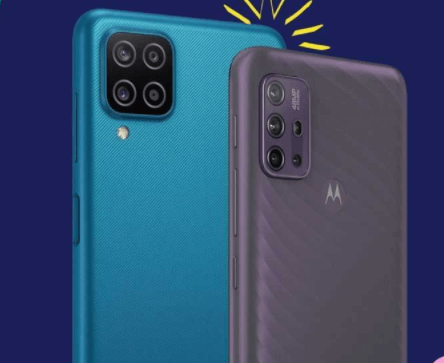
Motorola Moto G10 comes with four rear cameras and 64GB of storage) and an IP52 rating. This means it is protected from dust and splash damage.
The 48Mp wide-angle lens on the back is a higher resolution than what we’ve seen on this budget phone, and there are also ultra-wide macro and depth-of-field lenses. You can choose a fingerprint or face scanner to unlock your phone, giving you flexibility when wearing a mask or gloves.
On the other hand, the Galaxy is pretty skinny, so don’t expect fancy features. It has only 32GB of storage (expandable), three years, one selfie camera, and a face scanner to unlock the phone.
Samsung claims to have applied a ‘simple design aesthetic‘ to this phone, and it has an impressive screen-to-body ratio compared to a budget phone.
Conclusion:
These phones have much in common: a 6.5-inch low-resolution LCD screen, a large 5,000mAh battery, and NFC for contactless payments.
However, the Motorola Moto G10 has more processing power than the Samsung Galaxy A02s, runs the latest Android version, and the four rear cameras offer more versatility than the 3 Samsungs.
- 6.5 max vision HD+ display
- 48MP of Rear Camera
- With a Qualcomm SM4250 Snapdragon 460
- 4GB RAM along 64GB ROM
- 5000mAh Battery
This is an essential part of Samsung updating its software. Benefit from manufacturer security patches for four years from the release date. This means you can safely use your phone for much longer than Motorola.
- 6.5 edge to edge HD display
- 4 lens Camera experience
- Qualcomm Snapdragon 450 processor
- 2GB RAM with built-in 32GB of memory
- 5,000mAh battery
10. Motorola Moto G Power (2022) vs Galaxy S21 Ultra
The Samsung Galaxy S21 Ultra has a larger screen size of 6.8 inches compared to the 6.5-inch screen of the Motorola Moto G Power (2022). The Motorola Moto G Power 2022 has an IPS LCD screen, and the Samsung Galaxy S21 Ultra has a screen type. The display density of Galaxy phones is 515 PPI, and the display density of Moto G Power (2022) is only 270 PPI.

Regarding the screen-to-body ratio, Samsung’s phones have a better screen-to-body ratio of 89.8% than Motorola’s phones of 79.7%. Both mobiles have the same aspect ratio of 20:9.
The Samsung Galaxy S21 Ultra’s 108MP quad rear camera outperforms the Motorola Moto G Power 2022’s 50MP + 2MP + 2MP triple rear camera in terms of resolution. The Samsung S21 Ultra comes with a 40MP better front camera than the G Power 2022’s 8MP front camera, so if you want to click many selfies, the Samsung S21 Ultra is your better choice.
The Samsung Galaxy S21 Ultra’s more extensive 12GB RAM is better for gaming than the Motorola Moto G Power 2022’s lower 4GB RAM. The Samsung Galaxy S21 Ultra has more internal memory (256 GB) than the Motorola Moto G Power 2022 (64 GB). Both devices have memory card slots.
Both phones have the Android operating system, but the Power runs on version 12, and Galaxy S21 runs on version 11.
Conclusion:
SPowerg Galaxy S21 Ultra has better RAM than Motorola Moto G Power 2022. Galaxy S21 Ultra has more internal memory than Motorola Moto G Power 2022. Regarding display resolution, the Samsung Galaxy S21 Ultra has a 3200 x 1440 than the Motorola Moto G Power 2022, which has 1600 x 720.
- Impressive new design
- High resolution shoot up to 8K video
- 12/16GB of RAM with 512 GB internal storage
- With Snapdragon 888 Processor
- Android 11 plus One UI 3.1
11. Samsung Galaxy A41 VS Motorola Moto G9 Power
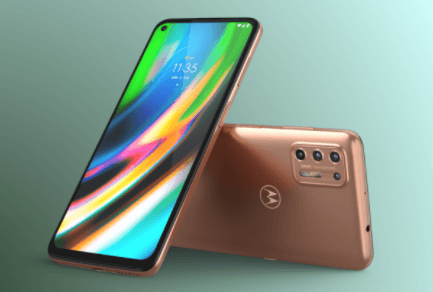
At 6.1 inches, it’s significantly smaller than the Moto G9 Power, but the AMOLED screen packs more pixels than Motorola’s LCD. These displays generally score well in our tests because they beautifully showcase the color and contrast of your content.
It has 64GB of storage (expandable) and four cameras, including a 48Mp wide-angle lens primary camera and a 25Mp selfie camera on the back. Samsung’s One UI 2 interface (layered on top of Android 10) should be as easy to use as Samsung’s more expensive phones.
On the other hand, the G9 Power has a 6.8-inch screen that might be cumbersome for some, but it means Motorola can charge a sizeable 6,000mAh battery. This should be enough for a busy day.
The G9 Power has an impressive 128GB of storage, which can be expanded if not enough. The camera shows a step up from a phone under $300 with a 64Mp wide-angle lens on the back. This is a higher resolution than we usually see.
Conclusion:
These Android 10 phones have the same amount of RAM (4GB), but the advantages lie in different areas.
Motorola has more internal storage, a battery almost twice its size, and a high-resolution, wide-lens rear camera.
But on the Galaxy A41 side, we have something better to see an OLED screen at this price point, which gives the display a more luxurious feel, and you get more than three years of software patches compared to 18 months for the Moto G9 Power.
- 6.9 max vision HD plus display
- 64MP of Rear camera system
- 4GB of RAM with a 128GB storage
- Qualcomm Snapdragon 662 processor
- 6000mAh of batt
12. Motorola Edge+ (2022) vs. Samsung Galaxy S22+
The Motorola Edge Plus 2022 and Samsung Galaxy S22+ are 2022’s newest high-end smartphones. Today’s flagship phones are better than ever. It’s expensive, but there are usually pieces that can back it up. It’s ridiculous how powerful a flagship smartphone can be, including cutting-edge processors, constantly improving cameras, faster-charging technology, and much more.
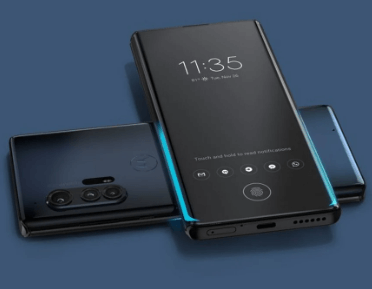
The Edge+ and the Galaxy S22+ have great specs and promising features and share the same starting price of $999. Both phones look solid on paper, but one is more accessible to recommend to most shoppers.
The new Motorola 2024 Edge+ phone offers a 6.7-inch OLED display with 2400 x 1080 resolution and a 144Hz refresh rate. On the other hand, Samsung’s new phone, S22+, has a 6.6-inch Dynamic AMOLED 2X display with 2340 x 1080 resolution and a 120Hz refresh rate. Each is large, vibrant, sharp, and buttery.
Samsung phones traditionally have the most intense colors and impressive brightness levels, but it’s hard to disappoint either way. Phones have a similar design. Includes a frosted glass back and a rear camera in the upper left corner. That said, Samsung’s design is a bit more refined.
The Galaxy S22 Plus, the phone’s flat-edged and contour-cut camera design, is surprising and unique over the somewhat generic aesthetic of the Moto Edge+. Samsung also hides the fingerprint sensor on the S22+ under the display, while the Edge+ integrates it into the power button on the right frame.
When it comes to cameras, things are changing in favor of Samsung. Both phones have a triple camera system, but the Edge+ is a bit deceptive. The third sensor is a 2MP depth camera and 50MP primary and 50MP ultra-wide cameras. In comparison, the S22+ feels more perfect. It has a 50MP primary camera, a 10MP telephoto camera, and a 12MP ultra-wide camera. This gives the S22+ several advantages.
The ultra-wide camera has a broader field of view than the Edge+, and the telephoto camera has much better zoom quality. Best of all, Samsung’s image processing is far ahead of Motorola’s. The Edge+ (2022) looks like one of Motorola’s better camera systems, but the Galaxy S22+ is the best choice for serious shutterbugs.
Looking inside the phone, the Motorola Edge+ starts to find its place again. Snapdragon 8 Gen 1 processor powers Edge+ and Galaxy S22+. This is the fastest mobile chip Qualcomm will make in 2022. That means both phones have enough horsepower for every app/game you throw. Edge Plus and S22 phones have 8GB/12GB RAM options with up to 512GB of internal storage.
The battery situation is also very similar overall. The Motorola Edge+ features a 4800mAh battery, 30W wired, and 15W wireless charging. The Galaxy S22+ has a 4500mAh battery, 45W wired, and 15W wireless charging.
The 15W extra charging speed is nothing to laugh at, but what’s interesting is that the Edge+ comes with a 30W charger in the box, whereas the S22+ doesn’t.
Unfortunately for Motorola, the Galaxy S22+ hides one trick: software support. Edge+ has one of the weakest update policies for flagship smartphones. Motorola promises only two major Android updates and three years of security patches. The Galaxy S22+ has four years of Android updates and five years of security patches.
Conclusion:
If you spend around $800 to $900 on a smartphone, you should get a non-outdated smartphone in two years. If you add the Galaxy S22+’s better camera, more admirable display, sleeker design, and faster charging, it’s hard to recommend buying a Motorola Edge+.
The Edge+ (2022) is Motorola’s brave attempt to return to its flagship rival, but unfortunately, the Samsung Galaxy S22+ beats it in many ways.
- With autofocus video stabilization
- 50MP vivid detail camera
- Eye catching glass metal design
- 25W of fast charging
- Long lasting battery l
13. Moto G Power vs Samsung Galaxy A20s
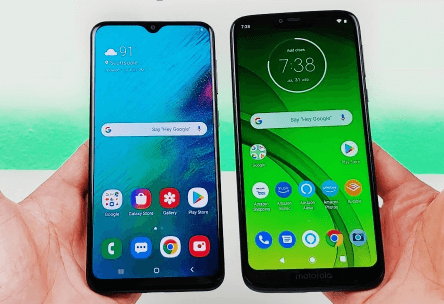
Moto G Power comes to mind when you think of a cost-effective mobile phone. Whether hardware or software, the phone delivers excellent results in every way. The full HD+ display is superb, the performance is high-speed, the battery lasts long, and Motorola’s custom Android interface is among the best on the market.
The Galaxy A20s is far less impressive than the Moto G Power. Almost all specs drop somewhat, so they have a much lower price tag. This makes the Galaxy A20s a worthy contender if the money is tight. All you need is a basic smartphone capable of performing your daily tasks, and you’re done.
Conclusion:
Overall, we should give Moto G Power this comparative win. This phone offers better specs in almost every category while maintaining an accessible price and supporting all US carriers. The Samsung Galaxy A20s aren’t all that impressive, but they offer a decent Android experience if you want to do basic things for as little as possible.
- 6.6 max vision ultra-wide screen
- 48 MP of triple camera system
- Qualcomm Snapdragon 662 processor
- 4BG of RAM with 64GB Storage
- Up to 3 days of battery life
- Android 10 operating system
14. Galaxy A32 5G VS Moto G 5G Plus
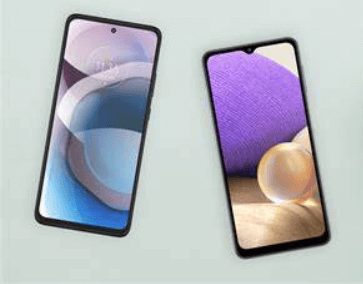
One of Samsung’s cheapest 5G smartphones, the A32 has 64GB of expandable storage, a large LCD screen (6.5 inches), and a battery (5,000mAh).
The MediaTek Dimensity 720 processor was tested relatively well, and with 4GB of RAM, it should handle most multitasking.
It has the same rear camera setup as the Motorola Moto G 5G plus but one less selfie camera with a 13Mp wide-angle lens on the front.
The 6.7-inch display on this phone is no surprise, as we’ve expected big screens from Motorola. It’s encouraging to see a screen-to-body ratio of 90%. This means you can take full advantage of its massive size while playing games or watching videos.
There’s plenty of room for a 5,000mAh high-capacity battery and plenty of storage space for 128GB. Qualcomm’s Snapdragon 765 processor powers it and has 6GB of RAM, giving it a fair bit of weight.
With four on the back (with a 48Mp wide-angle lens) and two for selfies, the camera department has also made great strides.
Conclusion:
It’s nice to see 4K video recordings on these two phones (a step up from a budget Phone) and 5G compatibility. Samsung has Android 11, and it benefits from a comprehensive update policy, so you can safely own it for a more extended period.
But if you’re looking for the best phone, for now, it’s hard to argue with Motorola’s much higher display resolution, extra 2GB of RAM, and additional selfie camera.
- 6.7 of FHD+ Cinema Vision Display
- 48MP of great rear camera
- Qualcomm Snapdragon 765
- 4GB of RAM with 64GB ROM
- 5000mAh of battery capacity
15. Motorola Moto G31 vs. Samsung Galaxy A13
The screen size of the Motorola Moto G31 is 6.47 inches, which is less than the 6.6 inches of the Samsung Galaxy A13. The Motorola Moto G31 has an AMOLED screen type, and the Galaxy A13 has a screen type.
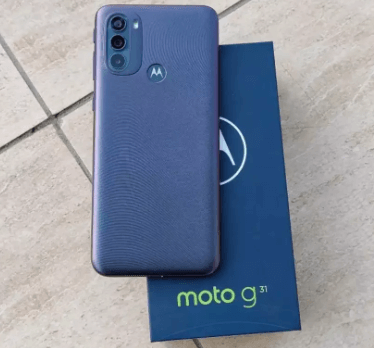
Moto G31 has a display density of 411 PPI, while Moto G31 has a display density of only 400. In terms of screen-to-body ratio, Motorola’s G31 has a better screen-to-body ratio of 88.8% than Samsung Galaxy’s A13, which is 83.2%. Both phones have the same aspect ratio of 20:9.
The Motorola Moto G31 has a triple rear camera of 50MP + 8MP + 2MP, while the Galaxy phone has a 50MP quad rear camera on the Samsung Galaxy A13. The Motorola Moto G31 has a better 13MP front camera than the Samsung Galaxy A13’s 8MP front camera. For the selfie, the Galaxy A13 is a better choice.
Motorola Moto G31 and Samsung Galaxy A13 phones come with 4GB of RAM and have the same internal memory of 64GB. For external memory, both devices have memory card slots.
Moto G31 runs on Android 11, while the A13 runs on Android 12.
Conclusion:
The Motorola Moto G31 and Samsung Galaxy A13 have the same RAM. Both do not have a front flash. The Samsung Galaxy A13 has a resolution of 2408 x 1080, unlike the Motorola Moto G31, which has 2400 x 1080. Both have the same amount of internal memory.
There is a slight price difference between these two phones. The Motorola Moto G31 costs around $200, while the Samsung Galaxy A13 costs $50 extra ($249.99).
- 6.4 inches of AMOLED screen with 1080 x 2400 pixels
- MediaTek Helio G85
- 4GB of RAM with 128GB storage
- Android 11 operating system
16. Moto G Stylus 2022 vs. Samsung A53
If you are in the market for a new midrange phone, you will most likely consider the two phones we discuss here. Let’s compare Samsung Galaxy A53 5G and Motorola Moto G Stylus 5G (2022).
These two smartphones look a bit similar and use similar materials. Both devices include thin bezels, a central camera hole, and a flat-panel display. Both of these phones are made of plastic and glass. They come with a plastic frame, plastic backplate, and glass front. They don’t feel cheap, but they aren’t at all.
It feels pretty hefty when held in hand due to its size. The Galaxy A53 5G is tiny, but both devices are significant. The Moto G Stylus 5G (2022) is much larger, slightly more comprehensive, and thicker. Plus, it’s heavier than the Galaxy A53 5G.
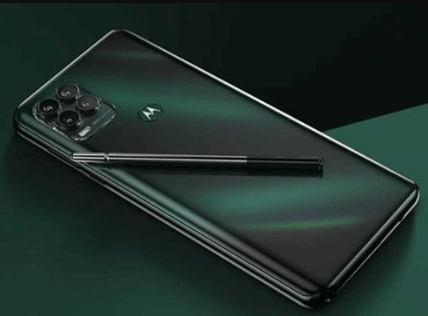
Neither phone feels particularly grippy, so keep that in mind. In both cases, it is better to use a case. The Galaxy A53 5G is IP67 waterproof and dustproof, and the Motorola Moto G Stylus 5G (2022) is water-repellent. Both are good in hand as long as you like significant devices. Otherwise, the opportunity will not appeal to you either. Both companies did an excellent job in the design department.
They have pretty different displays. The Samsung Galaxy A53 5G features a 6.5-inch fullHD+ (2400 x 1080) Super AMOLED panel. This display offers a 120Hz refresh rate and is far from the brightest panel but bright enough. Here, we are looking at a 20:9 display aspect ratio, and the board is protected by Gorilla Glass 5. The screen-to-body ratio of this phone is about 85.4%.
Let’s discuss the Motorola Moto G Stylus 5G (2022). That handset has a 120Hz flat panel display and an IPS LCD panel. It measures 6.8 inches and is a Full HD+ (2460 x 1080) panel. Motorola is using Gorilla Glass 3 to protect this display. The Gorilla Glass iteration is pretty old and doesn’t do much to prevent micro-scratches. The screen-to-body ratio of this handset is approximately 85.8%.
In terms of specs, both of these phones are mid-range. An Exynos 1280 SoC powers the Samsung Galaxy A53 5G and comes with 4GB, 6GB, or 8GB of RAM. Meanwhile, the Motorola Moto G Stylus 5G (2022) has a Snapdragon 695 and 8GB of RAM. By the way, neither phone uses the fastest LPDDR RAM or the fastest UFS flash storage. But at this price point, it’s to be expected.
Both phones have their own, but neither will win an award in the camera category. The Galaxy A53 5G has a 64-megapixel primary camera, a 12-megapixel ultra-wide-angle camera, and two 5-megapixel (macro and depth) cameras.
On the other hand, the Motorola Moto G Stylus 5G (2022) is equipped with a 50-megapixel primary camera, an 8-megapixel ultra-wide unit, and a 2-megapixel depth shooter.
Both phones work well in good lighting. The Moto G Stylus 5G (2022) sometimes enhances the colors too much, as does the sharpness. Other than that, both work great when well-lit.
These two smartphones have the same battery capacity. Both come with a 5,000mAh battery pack. However, the Galaxy A53 5G battery should occupy a relatively small display.
Neither device supports wireless charging, so let’s remove that first. When it comes to wired charging, the Galaxy A53 5G supports 25W charging. However, it is not included in the box, so you must get the adapter separately. The Moto G Stylus 5G (2022) only offers 10W charging, but the charger is included in the box.
The Galaxy A53 5G enables many uses on a single charge. We were able to cross the 8-hour screen-on-time mark several times without problems. Of course, the game will affect this like many other things. So I don’t prefer to talk about exact figures. But one thing is for sure. The Galaxy A53 5G has a long battery life. Motorola Moto G Stylus 5G (2022) battery life isn’t bad. It’s pretty good but close to what the Galaxy A53 5G offers.
Conclusion
These phones cost less than $500 in the US and are much cheaper. It could be closer to $300 and possibly even less if caught at the right time in 2024.
Both displays are good, but the Samsung Galaxy A53 5G takes the cake. In comparison, this panel offers better color, better contrast, and saturation. Unsurprisingly, Samsung has chosen to use its Super AMOLED panel here.
But the IPS LCD on the Motorola Moto G Stylus 5G (2022) is no joke. Both panels offer high refresh rates and feel great to use. They also provide good viewing angles.
The Moto G Stylus 5G (2022) loses color fidelity in low light, while the Galaxy A53 5G does not capture large amounts of detail in these conditions.
The ultrawide camera, to be honest, isn’t particularly good on either phone. They perform differently at lower levels, unlike the main shooters. But overall, the camera is excellent as long as it manages expectations.
- Comes with super AMOLED display
- Gives one of the most powerful performances in A series
- You can add additional 1TB of expandable storage with a microSD card
- Powerfull Snapdragon 695 processor
17. Samsung Galaxy M13 vs. Motorola Moto G32
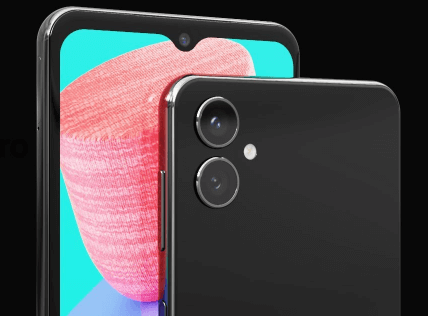
You can check the spec scores and unique features by comparing Motorola Moto G32 and Samsung Galaxy M13 4G. Currently, the lowest price for the Motorola Moto G32 is Rs 12,999, and the lowest price for the Samsung Galaxy M13 4G is Rs 11,999.
The Motorola Moto G32 measures 6.6 inches, and the Samsung Galaxy M13 4G measures 6.6 inches. The Motorola Moto G32 has 128GB of internal storage and 4GB of RAM. The Samsung Galaxy M13 4G has 64GB of internal storage and 4GB of RAM.
The former offers a 5000 mAh battery, and the latter provides a 6000 mAh battery. Regarding cameras, the former has a primary camera with a 50MP + 8MP + 2MP triple rear camera setup and a front camera with a 16MP f/2.4 primary wide-angle camera. In contrast, the latter has a primary camera of 50MP + 5MP+. 2MP dual rear camera setup and 8MP f/2.2 front camera, wide angle, primary camera.
Conclusion
Samsung Galaxy M13 and Motorola Moto G32 offer the same size screen, RAM, and more. However, the Moto G32 has more storage than Galaxy M13.
- 6.5 inches larger IPS LCD display with 1080 x 2400 pixels
- Has a Qualcomm Snapdragon 680
- Android 12 OS can upgrade to Android 13
- 4GB of RAM with 64GB storage
Pros and cons Motorola and Samsung brands
Let’s take a look at the pros and cons of each brand. Motorola is known for its strong battery life. Motorola is a good choice if you’re looking for a phone that will last all day.
On the other hand, Samsung is known for its beautiful displays. Samsung is a better choice for a phone with a high-resolution screen.
Samsung also has phones in a broader range of price ranges. Motorola might not be your best bet if you want something cheap.
Finally, Motorola phones are generally easier to use with fewer bells and whistles than Samsung phones. Motorola might be a better choice if you’re not interested in putting a lot of extras on your phone.
Frequently Asked Questions
Why Motorola is better than Samsung
Motorola has always been a brand focused on simplicity and quality. They don’t try to do too many things at once, and they don’t overcomplicate their product with tons of features you’ll never use.
On the other hand, Samsung is a brand that constantly strives to outpace its competitors. This often results in confusing and confusing products. Motorola never falls into this trap. Their products are streamlined and easy to use.
Motorola also has a more reliable history than Samsung. Phones are less likely to have glitches or software issues and tend to last longer without updates or repairs.
Overall, Motorola is a better brand than Samsung as its products are more straightforward, reliable, and easy to use.
Is Motorola a good phone brand?
Motorola, now owned by Lenovo, focuses on a consistent design ethic, has software close to Android, and often offers incredible value for money. The Moto G series continues to be an excellent choice for those looking for a genuinely excellent budget phone.
What is the rank of the Motorola brand?
Motorola is now the third-largest smartphone brand in the US.\
What is unique about Motorola phones?
In 1973, Motorola developed the world’s first mobile phone, and a decade later, the Company made history when the FCC approved the world’s first commercial mobile phone, the DynaTAC 8000X.
Is Motorola popular in America?
Motorola has emerged as the third-largest smartphone OEM in the United States. The Lenovo-owned Company doubled to the top in the United States last year.
Are Motorola phones safe?
Motorola smartphones are very safe. Motorola mobile phones can only be discovered by other devices when turned on for the first time or made discoverable by the user. Nevertheless, Motorola phones remain discoverable for only 60 seconds, severely limiting the amount of time an intruder can gain access.
Final words about Motorola vs Samsung phones 2024
Motorola is the better phone brand, after all. It offers better features at a lower price and top-notch customer service. Also, the phone is sleek, stylish, and up-to-date with the latest technology.
Samsung is a good brand, but not as good as Motorola. Their phones are usually more expensive and don’t have many features. Their customer service is also poor, and their phones are not constantly updated with the latest technology.
We highly recommend Motorola over Samsung for anyone looking for a quality phone at an affordable price.
Motorola and Samsung are great phone brands, but Motorola is better than Samsung. Motorola offers better features such as longer battery life, faster processing, and better camera quality. Samsung is also known for its great features, but Motorola surpasses it in many ways. Motorola is a better choice if you are looking for a great phone brand.





